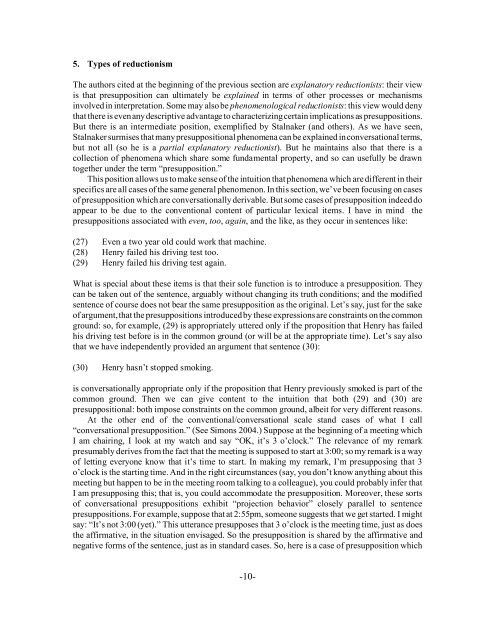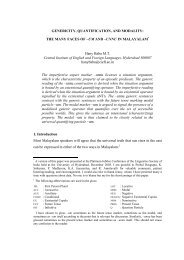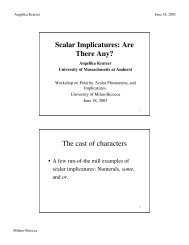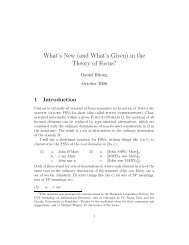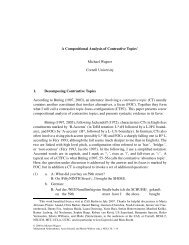Foundational Issues in Presupposition - New York University
Foundational Issues in Presupposition - New York University
Foundational Issues in Presupposition - New York University
Create successful ePaper yourself
Turn your PDF publications into a flip-book with our unique Google optimized e-Paper software.
5. Types of reductionism<br />
The authors cited at the beg<strong>in</strong>n<strong>in</strong>g of the previous section are explanatory reductionists: their view<br />
is that presupposition can ultimately be expla<strong>in</strong>ed <strong>in</strong> terms of other processes or mechanisms<br />
<strong>in</strong>volved <strong>in</strong> <strong>in</strong>terpretation. Some may also be phenomenological reductionists: this view would deny<br />
that there is even any descriptive advantage to characteriz<strong>in</strong>g certa<strong>in</strong> implications as presuppositions.<br />
But there is an <strong>in</strong>termediate position, exemplified by Stalnaker (and others). As we have seen,<br />
Stalnaker surmises that many presuppositional phenomena can be expla<strong>in</strong>ed <strong>in</strong> conversational terms,<br />
but not all (so he is a partial explanatory reductionist). But he ma<strong>in</strong>ta<strong>in</strong>s also that there is a<br />
collection of phenomena which share some fundamental property, and so can usefully be drawn<br />
together under the term “presupposition.”<br />
This position allows us to make sense of the <strong>in</strong>tuition that phenomena which are different <strong>in</strong> their<br />
specifics are all cases of the same general phenomenon. In this section, we’ve been focus<strong>in</strong>g on cases<br />
of presupposition which are conversationally derivable. But some cases of presupposition <strong>in</strong>deed do<br />
appear to be due to the conventional content of particular lexical items. I have <strong>in</strong> m<strong>in</strong>d the<br />
presuppositions associated with even, too, aga<strong>in</strong>, and the like, as they occur <strong>in</strong> sentences like:<br />
(27) Even a two year old could work that mach<strong>in</strong>e.<br />
(28) Henry failed his driv<strong>in</strong>g test too.<br />
(29) Henry failed his driv<strong>in</strong>g test aga<strong>in</strong>.<br />
What is special about these items is that their sole function is to <strong>in</strong>troduce a presupposition. They<br />
can be taken out of the sentence, arguably without chang<strong>in</strong>g its truth conditions; and the modified<br />
sentence of course does not bear the same presupposition as the orig<strong>in</strong>al. Let’s say, just for the sake<br />
of argument, that the presuppositions <strong>in</strong>troduced by these expressions are constra<strong>in</strong>ts on the common<br />
ground: so, for example, (29) is appropriately uttered only if the proposition that Henry has failed<br />
his driv<strong>in</strong>g test before is <strong>in</strong> the common ground (or will be at the appropriate time). Let’s say also<br />
that we have <strong>in</strong>dependently provided an argument that sentence (30):<br />
(30) Henry hasn’t stopped smok<strong>in</strong>g.<br />
is conversationally appropriate only if the proposition that Henry previously smoked is part of the<br />
common ground. Then we can give content to the <strong>in</strong>tuition that both (29) and (30) are<br />
presuppositional: both impose constra<strong>in</strong>ts on the common ground, albeit for very different reasons.<br />
At the other end of the conventional/conversational scale stand cases of what I call<br />
“conversational presupposition.” (See Simons 2004.) Suppose at the beg<strong>in</strong>n<strong>in</strong>g of a meet<strong>in</strong>g which<br />
I am chair<strong>in</strong>g, I look at my watch and say “OK, it’s 3 o’clock.” The relevance of my remark<br />
presumably derives from the fact that the meet<strong>in</strong>g is supposed to start at 3:00; so my remark is a way<br />
of lett<strong>in</strong>g everyone know that it’s time to start. In mak<strong>in</strong>g my remark, I’m presuppos<strong>in</strong>g that 3<br />
o’clock is the start<strong>in</strong>g time. And <strong>in</strong> the right circumstances (say, you don’t know anyth<strong>in</strong>g about this<br />
meet<strong>in</strong>g but happen to be <strong>in</strong> the meet<strong>in</strong>g room talk<strong>in</strong>g to a colleague), you could probably <strong>in</strong>fer that<br />
I am presuppos<strong>in</strong>g this; that is, you could accommodate the presupposition. Moreover, these sorts<br />
of conversational presuppositions exhibit “projection behavior” closely parallel to sentence<br />
presuppositions. For example, suppose that at 2:55pm, someone suggests that we get started. I might<br />
say: “It’s not 3:00 (yet).” This utterance presupposes that 3 o’clock is the meet<strong>in</strong>g time, just as does<br />
the affirmative, <strong>in</strong> the situation envisaged. So the presupposition is shared by the affirmative and<br />
negative forms of the sentence, just as <strong>in</strong> standard cases. So, here is a case of presupposition which<br />
-10-


